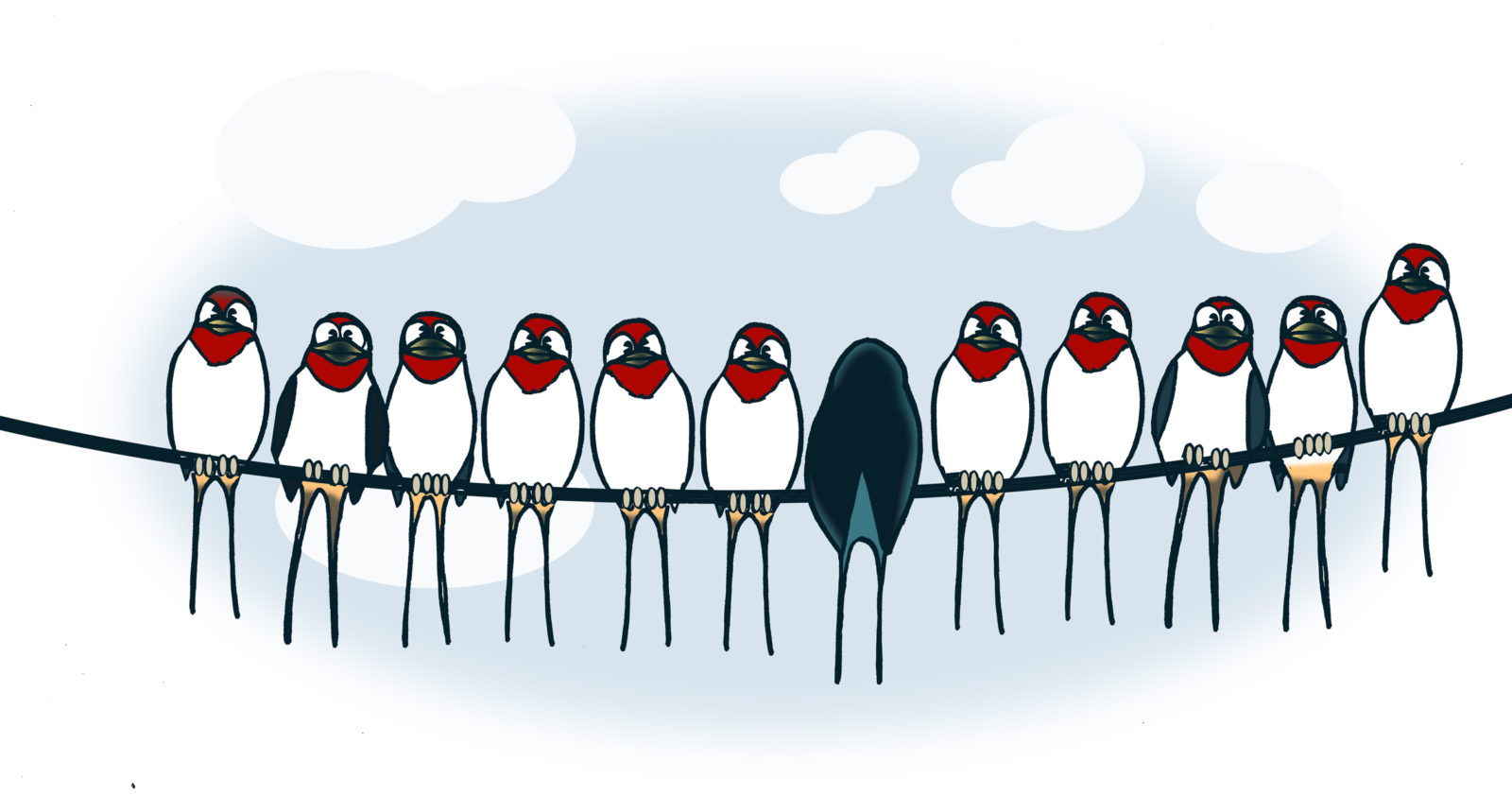For children and educators

Events
- Kids’ Birdwatching Week takes place each year in May. The purpose of the event is to get to know birdwatching and birds by seeking signs of their nesting. No bird species have to be identified. We have a lot of free material in English to help you with the trip. The event is free of charge, without age limit and no prior registration is required.
- See also Pihabongaus in January (in Finnish and Swedish, also for schools), Bongaa päivä pihalla in May (in Finnish and Swedish), Pönttöbongaus in June (in Finnish and Swedish) and EuroBirdwatch in October (in Finnish).
Materials
- See the Finnish materials page for coloring sheets etc.
- Kids’ Birdwatching Week offers materials in English regarding the signs of nesting of birds.
Bird-live
BirdLife’s live cameras take you directly to the birds. Topics vary by season.
Getting outdoors with children
Five parts of a successful nature trip
- Weather-appropriate clothing and shoes. Rainwear and an extra sweater are easy to carry in a backpack, for example. Rain boots are great hiking boots for places that are even slightly wet. A hat is important even in the summer.
- Snacks. Everyone loves a snack break! Even on short trips, it is good to take at least something to drink and a few biscuits or fruits with you. For a trip lasting more than 3 hours, you will need a bigger snack, and for a trip of more than 6 hours, a filling meal.
- Keep your senses open and observe. You can see and hear more if you walk calmly and without making too much noise. You can use your senses of smell and touch too, sometimes even your taste. Small observations can give you great joy.
- Respect nature and other people. The Finnish “everyman’s rights” or public access rights say that you must not cause damage or disturb others while outdoors. More on everyman’s rights: https://www.ymparisto.fi/en-US/Nature/Everymans_rights.
- Safety. Take the basic first-aid equipment (plasters, gauze, disinfectant) on every trip. A map and a compass are basic equipment in more unfamiliar areas. A charged phone is also good to have with you, but you should not depend on it.
Where to go?
It is not necessary to go far to observe birds – the school backyard may be enough. Birds can be seen almost anywhere. Good places to observe birds include gardens with bushes, rich sea bays and estuaries, varied farmlands, pastures, fields, open mires, lush groves, mixed forests and high hills. The best sites have birdwatching towers, marked paths and nature trails. Landfills, wastewater treatment plants and markets also attract a lot of birds. Children, like beginner birdwatchers in general, are usually better at watching than listening to birds. A bay rich with waterbirds is therefore often a better destination than a dense forest and its songbirds. On the other hand, forest is a great place for an adventure-based trip.
Here are some basic tips for different locations. The bird species that are most common and easy to observe are listed for each environment. However, identifying the species is not essential – shared nature experiences are the important thing.
- Nearby nest boxes
If you cannot find the birds, the birds can be brought to you! You can easily see birds by observing the nest boxes near you in spring and early summer. In winter, you can already prepare for the next breeding season and future birdwatching trips by building nest boxes. Common species: Great Tit, Blue Tit, Pied Flycatcher, Common Starling. - Urban areas
A surprising number of birds are adapted to living in built environments. They have learned to nest on roofs, in the cavities of buildings or in the trees in parks, and they find a lot to eat from human leftovers, markets and litter bins. Common species: Feral Pigeon (“city pigeon”), Common Gull, Herring Gull, Black-headed Gull, House Sparrow, Jackdaw, Hooded Crow, Common Magpie. - Yards and gardens
The holes in buildings, woodpiles, hedges, trees etc. offer many nest sites to birds outside the cities as well. In addition, lush yards and gardens are full of plants and insects to eat, so some bird species can be seen there even if they do not nest in (ordinary) nest boxes. In winter, even tens of different bird species may gather in bird feeding stations outside. Common species: White Wagtail, Spotted Flycatcher, Barn Swallow, Greenfinch, Fieldfare, Blackbird, Jackdaw, Hooded Crow, Common Magpie, Wood Pigeon and the nest box species mentioned above. - Waters and shores
Waterbirds are pleasant to watch – they are often quite large, distinctly coloured and stay fairly still when swimming. In spring, waterbirds gather in ice-free areas in great numbers. In summer, you can observe their breeding and their chicks. Some birds, such as swans and grebes, build pile-like nests that can be observed from a birdwatching tower, for example. Gulls and terns often nest on open rocks and islets, so it is easy to see an incubating parent bird or young birds waiting to be fed on a rock. Many ducks and geese hide their nests well, but the chicks start following their parent as soon as they hatch, and broods are easily observed in water swimming with their parent. Common species: Mallard, Common Goldeneye, Mute Swan, Whooper Swan, Canada Goose, Barnacle Goose, Great Crested Grebe, Red-necked Grebe, Goosander, Common Gull, Herring Gull, Black-headed Gull, Common Tern, Arctic Tern. - Forests
Birds are more difficult to see in forests, but in April–May, the chorus of singing birds is beyond compare especially at dawn. By learning a few of the most common birdsongs you can already identify the majority of the sounds in a forest. Even if you do not know any bird species, listening for their alarm calls can lead you to nesting birds and even to the predators threatening them, such as crows and owls. Common species: Chaffinch, Willow Warbler, Willow Tit, Tree Pipit, Redwing, Great Spotted Woodpecker. - Fields and meadows
Easily identifiable birds nest in open fields. Many species who nest in trees also hunt for earthworms and other food in the fields and meadows. Binoculars are often needed to see the birds properly in open country. Common species: Skylark, Northern Lapwing, Northern Wheatear, White Wagtail, Common Starling, thrushes and gulls.
Things to consider when outdoors with children
Knowledge and skills
- Consider the age group and the children’s abilities. For pre-school children, shared experiences are the most important thing. At the age of 10 to 13 on average, the child has enough skills to learn even detailed species identification.
- As an adult, you do not have to know everything – you can learn new things together. Get to know common bird species by using prepared materials, books or internet and, for example, by drawing.
- At the beginning of your trip, teach the children how to use the binoculars or the potential spotting scope. With the smallest children, you will not need any binoculars at all, and in any case, they are not necessary.
The course of the trip
- The walking distance and the duration of the trip should be chosen according to the participants. For the smallest children, a short trip to the forest behind the house or to the shore is enough.
- A child does not necessarily make a distinction between birds and the rest of nature, so be prepared to watch plants, bugs etc. as well.
- Let the children direct the course of the trip as much as possible. Taking a trip in nature is not a performance, and the children often want to stop to look more closely at the bug they found, for example.
- On the other hand, children do not often have the patience to e.g. stand in a birdwatching tower for several hours. Move around or plan some other activities for your trip as well.
- Getting outdoors, observing and eating your snacks can well be enough of a program for your trip. If you wish, you can also include other activities, such as games, crafts or observation exercises.
Attitude and rules
- Children learn from adults. Show by your example how to respect nature, follow the everyman’s rights and the outdoor areas’ rules, and how to take others into consideration.
- Tell the children how to behave in nature: what is allowed, what is not allowed – and why not. Littering damages nature, making noise disturbs the animals, and plants should not be harmed unnecessarily, because they will suffer from it in the long run.
- You do not have to prohibit picking plants entirely, but it is good to learn to think twice before picking up every flower you see. In nature reserves, you must not pick up any plant. Learn also to identify the most common protected or toxic plant and mushroom species.
- Keep your mind open to be enchanted by the little wonders of nature with the children. Stop to watch, listen, smell and feel. Do not teach the children to be scared of nature, e.g. bugs or snakes. You can observe them as well, from a respectful distance, if needed.
- Do not take too much pressure. There can be a lot to look at in ordinary pigeons, crows and ducks. Even if you do not see any birds at all, the moments shared in nature are what matter.


